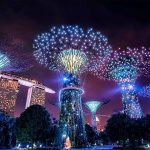Singapore, often hailed as a tech utopia, is brimming with innovative landmarks that are a testament to its technological prowess. As a tech enthusiast myself, I’ve always been fascinated by how this city-state blends cutting-edge technology with its urban landscape, creating a futuristic vibe that’s hard to find anywhere else.
From awe-inspiring architectural marvels to interactive museums, Singapore’s tech landmarks are not just about showcasing advancements but also about offering immersive experiences.
What are Singapore’s Must-visit Tech Landmarks?
Singapore’s must-visit tech landmarks include the ArtScience Museum for its intersection of technology and art, the futuristic Gardens by the Bay with its Supertree Grove, and the Smart Nation Pavilion, showcasing Singapore’s smart city initiatives.
I’ve explored some of these spots, and trust me, they’re a tech lover’s dream come true. Whether you’re a gadget geek or just curious about the future of technology, these places are sure to amaze and inspire. Let’s dive into the heart of Singapore’s tech scene and discover the must-visit landmarks that make this city truly unique.
Marina Bay Sands SkyPark
When I first laid eyes on the Marina Bay Sands SkyPark, it felt like stepping into a scene from a sci-fi movie. Its iconic boat-shaped top, perched on three towering skyscrapers, is not just an architectural marvel but a testament to Singapore’s ambition in merging luxury with innovative technology. The SkyPark is a pinnacle of design, offering breathtaking 360-degree views of the cityscape that are unmatched anywhere else in Singapore.

The tech aspect of the SkyPark truly sets it apart. State-of-the-art environmental systems sustain its stunning rooftop garden, and the entire structure is a marvel of modern engineering. The observation deck, which offers a vantage point like no other, utilizes advanced materials and design techniques to handle the influx of visitors while ensuring safety and comfort. The infinity pool, perhaps the most photographed part of Marina Bay Sands, showcases an ingenious overflow system that maintains its picturesque water level seamlessly against the skyline.
But it’s not just about the view or the pool; the SkyPark is an interconnected hub of technology. From the lighting that subtly shifts to complement the time of day, to the sound systems that provide an immersive experience as you walk through the gardens or dine in the restaurants, everything is carefully curated to ensure a blend of sensory and technological delight.
Visiting the Marina Bay Sands SkyPark gave me a deep appreciation for how Singapore harnesses technology to enhance not just functionality but also beauty and visitor experience. It’s a bold statement of luxury, yes, but also of foresight and innovation. Walking through the SkyPark, with the city’s pulse below and the sky stretching infinitely above, I felt truly immersed in the vision of a future where technology and daily life intertwine seamlessly.
Gardens by the Bay
When I ventured deeper into Singapore’s tech wonders, Gardens by the Bay stood out as a testament to the city-state’s innovative spirit. This sprawling garden, nestled against the Marina Bay waterfront, is not just a haven for nature lovers but a showcase of cutting-edge horticultural and architectural technology.

Spanning over 101 hectares, Gardens by the Bay is home to more than 1.5 million plants from over 19,000 species, making it a biodiversity hotspot unlike any other. However, it’s the integration of technology that truly sets it apart. The garden’s renowned Supertrees are a prime example. These vertical gardens, some towering up to 50 meters, are equipped with solar cells that harness sunlight to mimic the ecological function of trees, from photosynthesis to water absorption.
| Feature | Detail |
|---|---|
| Area | 101 hectares |
| Plant species | Over 19,000 |
| Tallest Supertree | 50 meters |
| Solar Cells | Integrated into Supertrees |
In the climate-controlled conservatories, the Flower Dome and the Cloud Forest, I was amazed by the sustainable engineering marvels. The Flower Dome, for instance, is listed in the Guinness World Records as the largest glass greenhouse in the world. It uses advanced cooling technology to create a Mediterranean climate, allowing plants that wouldn’t normally survive in Singapore’s climate to thrive.
My visit to the Cloud Forest introduced me to one of the world’s tallest indoor waterfalls. The mist-filled conservatory showcases plant life from tropical highlands up to 2,000 meters above sea level. Behind the scenes, innovative technologies recycle water and ensure optimal humidity levels to mimic natural conditions, demonstrating an exceptional commitment to sustainability and conservation.
Exploring Gardens by the Bay, it was evident that Singapore’s reputation as a “City in a Garden” was not just a vision but a reality. The melding of cutting-edge technology with natural beauty to create this green urban oasis truly highlights Singapore’s forward-thinking approach.
National Gallery Singapore
When I stepped into the National Gallery Singapore, I immediately grasped its significance not just as an art museum but also as a beacon of technological innovation in the heart of the city. Housing the world’s most comprehensive public collection of Singaporean and Southeast Asian art, this monumental institution merges cultural heritage with the very forefront of technology to enhance the visitor experience in ways that are both subtle and profound.
One of the most striking aspects of the National Gallery is its Smartify App. This clever use of technology allows you to scan artworks to receive instant information about them, turning a simple visit into an interactive learning experience. It’s not every day that you find an art gallery that encourages you to take out your phone and dive deeper into the art in front of you, but here, it’s part of the journey.

In addition to innovative apps, the Gallery uses Advanced Environmental Controls to preserve its vast collection. Singapore’s tropical climate poses significant challenges for art preservation, but the Gallery’s state-of-the-art climate control systems ensure that temperature and humidity are kept within strict, art-preserving parameters. This invisible tech works tirelessly behind the scenes to protect these national treasures for future generations to marvel at.
The building itself is a marvel of architectural technology. Merging the historical City Hall and Old Supreme Court buildings, it features adaptive re-use at its finest, with modern interventions like the Veil and Vault structure that supports its vast roof garden. This isn’t just about aesthetics; it’s a testament to how contemporary engineering solutions can give life to old structures in a city as forward-thinking as Singapore.
As I moved through the vast spaces of the National Gallery Singapore, I was constantly reminded of how technology can bridge the gap between historical legacy and future innovation. It stands as a striking example of Singapore’s commitment to integrating technology in every facet of urban life, including the preservation and celebration of its rich cultural heritage.
ArtScience Museum
Once I stepped into the ArtScience Museum, it was evident why this place is a pinnacle of Singapore’s tech scene. Nestled in the heart of Marina Bay Sands, this lotus-inspired structure isn’t just a building; it’s an intersection of art, science, culture, and technology that challenges the very boundaries of traditional museums.
The museum’s architecture itself is a marvel. Designed by Moshe Safdie, its ten fingers reaching towards the sky aren’t just for show. They’re integral to the building’s sustainability features, harvesting rainwater to be recycled and used within the museum. Walking through its galleries, I was struck by the seamless integration of technology into each exhibit, making every visit a unique, interactive experience.
One of the standout exhibitions that I explored was “Future World: Where Art Meets Science”. It’s a permanent installation that’s constantly evolving, ensuring that no two visits are the same. Here, digital interactive artworks react in real-time to my presence and movements, creating a symphony of light, sound, and color that’s both mesmerizing and thought-provoking. It’s a tangible demonstration of how technology can transcend traditional art forms to create entirely new experiences.
The museum’s commitment to showcasing the convergence of art and technology is also evident in its rotating exhibits. From exploring the depths of the ocean through virtual reality to understanding the complexities of space exploration, each exhibit is meticulously curated to educate, inspire, and ignite curiosity. The ArtScience Museum is more than just a museum; it’s a gateway to the future.
As I moved from one exhibit to the next, it was clear that the ArtScience Museum is a testament to Singapore’s forethought in creating spaces where technology and creativity collide. It’s not just about viewing art; it’s about experiencing it in a whole new way, and that’s what makes it a must-visit tech landmark in Singapore.
Innovation and Entrepreneurship Hub
As I delve deeper into Singapore’s tech scene, it’s impossible not to notice how the city-state has become a thriving Innovation and Entrepreneurship Hub. This is largely due to its robust ecosystem that supports the growth of startups and innovative enterprises. One of the cornerstones of this ecosystem is Block71. Situated in the heart of the city, Block71 is more than just a space; it’s a dynamic community where entrepreneurs, mentors, and investors come together.
Block71 is not just a building—it’s an initiative by NUS Enterprise in collaboration with Singtel and the Media Development Authority. This hub aims to ignite and propel Singapore’s tech startup scene onto the global stage. It provides startups with access to valuable resources such as mentorship programs, networking events, and funding opportunities. The success stories emerging from Block71 are a testament to its impact on the local and international tech landscape.
Another significant player in fostering innovation is the SGInnovate. SGInnovate specializes in connecting aspiring entrepreneurs with the right mentors and investors. Their focus on deep tech sectors like artificial intelligence, blockchain, and medtech has made them pivotal in transforming ideas into world-changing realities.
| Key Players in Singapore’s Tech Scene | Focus Areas |
|---|---|
| Block71 | Tech Startups, Global Networking |
| SGInnovate | Deep Tech, AI, Blockchain |
Exploring these hubs has given me a deeper understanding of why Singapore is acclaimed as a global tech leader. The synergy between governmental support, industry collaboration, and a vibrant community of innovators is driving the nation’s tech advancements to new heights. These places aren’t just landmarks; they’re the breeding grounds for tomorrow’s technological breakthroughs.
Conclusion
Exploring Singapore’s tech landmarks has been an enlightening journey. From the breathtaking Gardens by the Bay to the innovative ecosystems of Block71 and SGInnovate, it’s clear that Singapore is a hub for tech enthusiasts and innovators.
The city-state’s commitment to fostering a culture of innovation and collaboration is evident in every corner. Whether you’re drawn to the beauty of technology-infused art at the National Gallery and ArtScience Museum or looking to dive into the heart of startup growth and development, Singapore offers a unique blend of opportunities.
My journey through these landmarks has not only showcased the technological prowess of Singapore but also highlighted the vibrant community driving this progress forward. If you’re passionate about technology and innovation, Singapore’s tech scene is a treasure trove waiting to be explored.

I’m Dinesh, the avid traveler and voice behind TechJetSet. Alongside my family, I’ve explored numerous countries, sharing our adventures and practical travel tips to inspire and guide fellow wanderers.







